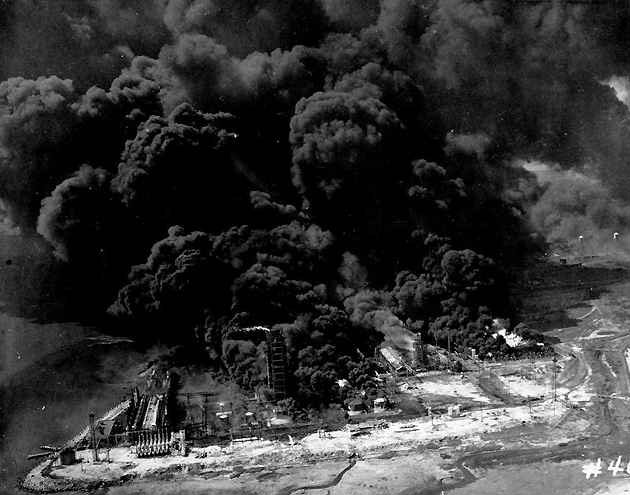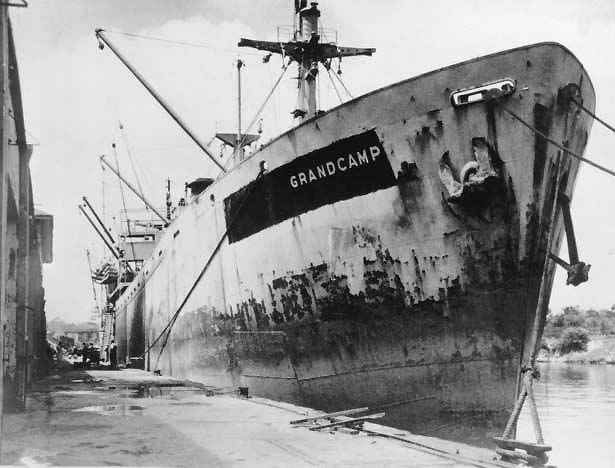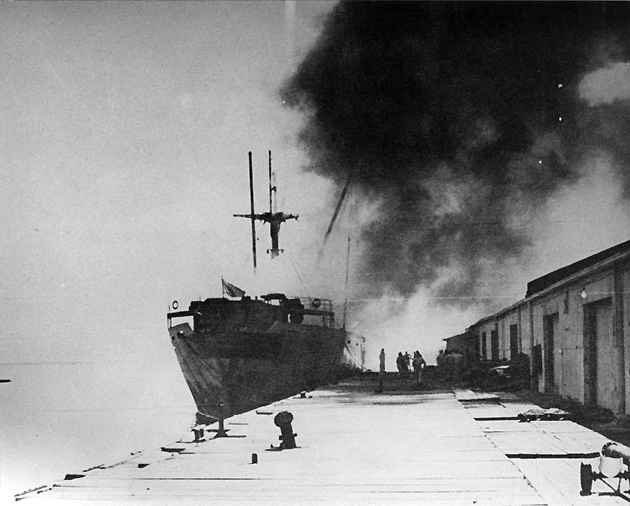The deadliest ship explosion in the United States, blowing away barges and aircraft
A barge was blown off the water while the plane was blown off its wings because of the power of the explosion.
The video shows a horrific explosion in the American city of Texas, known as the Texas City Disaster. The pillar of black smoke rises high, the harbor house is ruined after a ship carrying 2,300 tons of explosive substances burns. And this explosion is also a premise for another explosion later.

Photograph of the Grandcamp in Texas in 1947, followed by a series of other explosions.
The fire
Video of the Texas city disaster in 1947.
The Texas city disaster began on April 16, 1947. The weather that day was quite cold with temperature of 13 degrees and wind of 32 km / h. The SS Grandcamp freighter arrived at the city of Texas five days earlier, according to Texas City Library.
Previously, Grandcamp stopped in Belgium to get 16 boxes of ammunition weapons on board. After crossing the Atlantic, the ship docked in Cuba and Houston, USA to exchange goods before anchoring in the Texas port city. Grandcamp arrived at Texas port to put ammonium nitrate fertilizer on board. Ammonium nitrate is a chemical compound used in fertilizers and extremely explosive.
On April 16, about 2,300 tons of fertilizer was loaded into the cargo compartment. At 8am that morning, 8 workers packed into the ship to do their job.

The Grandcamp ship then carried 2,300 substances extremely explosive.
Soon after, they smelled smoke. When checking in, the workers discovered a small fire in the ship. They tried to put out the fire with a few water bottles and fire extinguishers, but the fire continued to spread.
8:25 am, the fire truck is coming. However, at this point, the area below the cargo compartment heats up so fast that the water cannot extinguish the fire.
Weapons of ammunition are located in Grandcamp's No. 5 compartment, separate from the fire with a steel fence. Workers are required to remove ammunition from the cavity 5. However, they can only move 3/16 boxes, then manage to issue orders out of the ship.
Upon learning that most ammunition was still on board, sailors immediately evacuated, fearing the ship exploded. The captain of the ship decided to try to extinguish the fire by releasing steam into the cargo compartment. He hopes this helps to extinguish the fire without damaging the goods.

Smoke rises from the fire on the Grandcamp.
But this is a serious mistake. The vapor has liquefied ammonium nitrate, producing dinitrogen monoxide, an extremely volatile substance. Steam also heats the cargo compartment No. 2 and 4, increasing the temperature. Grandcamp's internal heat quickly reaches 450 degrees Celsius, the temperature at which ammonium nitrate will explode. Fuel oil located in compartments 3 and 4 also leaks into the ammonium nitrate bags, making the fire even more aggressive.
The first explosion
The fire from the Grandcamp created a thick, high column of smoke, visible throughout the city. The people of the city flock to the harbor to see the fire-fighting activities. And this explains why so many casualties when Grandcamp exploded.
Ammonium nitrate on Grandcamp ship exploded at 9.12am, melting wrecks, blowing debris to 600-900m high.
The fireball created by the explosion can be seen many kilometers away. Two nearby passenger planes have broken their wings, forced to make an emergency landing.
The explosion created a 4.5m high wave hitting the pier and flooding the surrounding area. Windows in Houston, 64km from the port, broke a series. People in Louisiana, 400km away, felt the shaking.

Photo of Texas City's pier after the explosion.
Most buildings near the explosion were flattened. Monsanto factory, just 90 meters away, was also destroyed by the explosion.
The warehouse of Texas City Railways along the harbor also suffered great damage. Hundreds of employees, pedestrians and witnesses were killed.
And yet, debris from the explosion flew into huge barrels of oil and chemicals at refineries. Explosion continues to occur here.
A barge named Longhorn II anchored at the port was even blown off the water because of the power of the explosion, falling 30 meters from the shore.
The director and 27 employees from the Texas City Fire Department were killed in the first explosion.

Longhorn II barges were even blown out of the water due to the explosion.
The second explosion
At the time of the first explosion, only two other ships docked at the port: SS High Flyer and Wilson B. Keene, both of which were cargo ships like the Grandcamp.
The High Flyer was close to Grandcamp, finished, but still waiting for repairs. The Wilson B. Keene is farther away and is being put on board.
In addition to carrying about 1,000 tons of ammonium nitrate fertilizer, High Flyer also carries 2,000 tons of sulfur. This is very dangerous because ammonium nitrate is more volatile when combined with sulfur. The impact from the first blast broke the High Flyer's anchor, causing the ship to drift.
High Flyer authorities caught fire and ordered all cups to pull ships out of the harbor. Fear of another explosion, the High Flyer captain ordered the anchor to be pulled up to drive the ship away from Grandcamp.

Rescue forces find people trapped in rubble.
Unfortunately, sailors cannot lift the High Flyer's anchor and the ship continues to drift closer to Grandcamp. After an hour of trying to lift the anchor, the High Flyer sailors left the ship. Finally, the second ship also burned.
At 1:10 am on April 17, only 15 hours after the first explosion, High Flyer also exploded, causing at least two people to die and causing additional damage to the port. The second blast also destroyed Wilson B. Keene, only a few meters from High Flyer.
Consequence
While there is a lot of information about the exact number of casualties, it is estimated that 500-600 people died in the explosion. The number of injured people is believed to be thousands. According to Live Science, the Texas disaster left some 3,500 wounded.
The exact number of people killed is not verified because many bodies are not intact. In addition, there are many foreign sailors and unlicensed workers in the port who are not listed. So far, the Texas disaster is still considered the deadliest industrial accident in US history and one of the largest non-nuclear explosions in the world.
- The largest ship explosion in history, killing 2000 people, leveling seaports
- The flight from London to New York is 11 minutes
- Robot is planning to stealth aircraft in the United States
- The United States built unmanned aircraft to land by tail
- Learn about the F-22, a type of US banned aircraft
- Mars is about to welcome guests from the United States
- Ship history (part 2)
- China designed the aircraft to fly to the United States in just two hours
- Answer the mystery about the ship at the foot of the New York Twin Towers
- Consolidating the hypothesis that the Tunguska explosion in 1908 was caused by comets
- Unmanned aerial vehicles will serve the US Navy
- Testing the plane takes 46 minutes across the United States
 'Fine laughs' - Scary and painful torture in ancient times
'Fine laughs' - Scary and painful torture in ancient times The sequence of numbers 142857 of the Egyptian pyramids is known as the strangest number in the world - Why?
The sequence of numbers 142857 of the Egyptian pyramids is known as the strangest number in the world - Why? History of the iron
History of the iron What is alum?
What is alum?